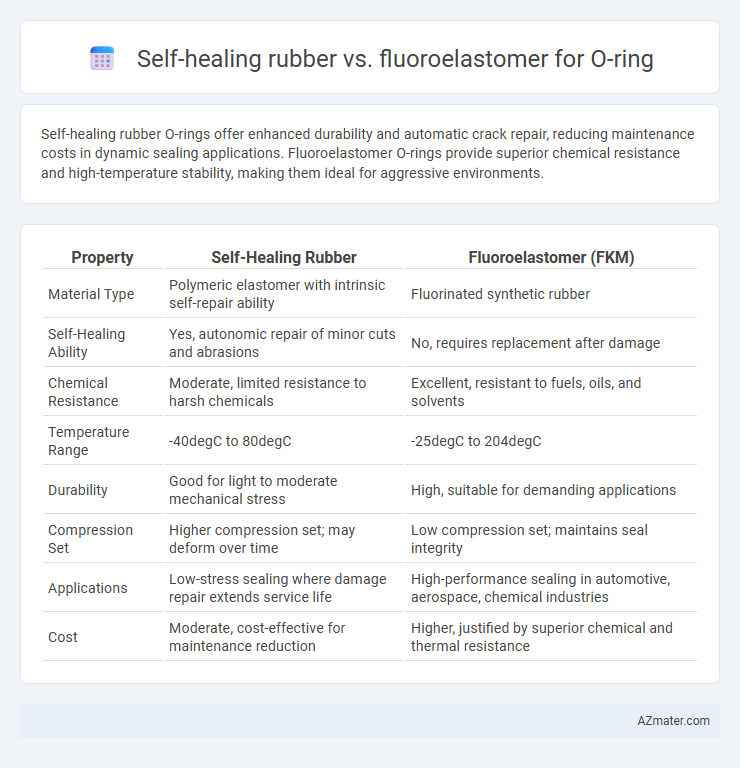Self-healing rubber O-rings offer enhanced durability and automatic crack repair, reducing maintenance costs in dynamic sealing applications. Fluoroelastomer O-rings provide superior chemical resistance and high-temperature stability, making them ideal for aggressive environments.
Table of Comparison
| Property | Self-Healing Rubber | Fluoroelastomer (FKM) |
|---|---|---|
| Material Type | Polymeric elastomer with intrinsic self-repair ability | Fluorinated synthetic rubber |
| Self-Healing Ability | Yes, autonomic repair of minor cuts and abrasions | No, requires replacement after damage |
| Chemical Resistance | Moderate, limited resistance to harsh chemicals | Excellent, resistant to fuels, oils, and solvents |
| Temperature Range | -40degC to 80degC | -25degC to 204degC |
| Durability | Good for light to moderate mechanical stress | High, suitable for demanding applications |
| Compression Set | Higher compression set; may deform over time | Low compression set; maintains seal integrity |
| Applications | Low-stress sealing where damage repair extends service life | High-performance sealing in automotive, aerospace, chemical industries |
| Cost | Moderate, cost-effective for maintenance reduction | Higher, justified by superior chemical and thermal resistance |
Introduction to O-ring Materials
O-ring materials are crucial for ensuring reliable sealing performance in various applications, with self-healing rubber and fluoroelastomer representing advanced options. Self-healing rubber offers enhanced durability by autonomously repairing minor damages, reducing maintenance needs, while fluoroelastomer provides exceptional chemical resistance and high-temperature stability. Selecting between these materials depends on specific operational conditions such as exposure to aggressive chemicals, temperature ranges, and the demand for longevity and resilience in sealing solutions.
What is Self-Healing Rubber?
Self-healing rubber is an innovative elastomer capable of autonomously repairing minor cuts and punctures, enhancing the durability and lifespan of O-rings without manual intervention. This material features dynamic covalent bonds or reversible cross-links that allow molecular chains to re-form, restoring mechanical integrity after damage. Compared to fluoroelastomers, which offer excellent chemical and heat resistance, self-healing rubber prioritizes sustainability and maintenance reduction through its regenerative properties.
Understanding Fluoroelastomer (FKM)
Fluoroelastomers (FKM) offer exceptional chemical resistance and high-temperature stability, making them ideal for O-rings in aggressive environments such as automotive fuel systems. Unlike self-healing rubber, FKM materials maintain their integrity under exposure to fuels, oils, and chemicals, ensuring long-term sealing performance and durability. The unique fluorine content in FKM imparts superior resistance to swelling and degradation, critical for demanding sealing applications.
Key Performance Factors for O-rings
Self-healing rubber O-rings excel in maintaining integrity under mechanical damage due to their inherent ability to autonomously repair micro-tears, ensuring prolonged sealing performance in dynamic applications. Fluoroelastomer O-rings offer superior chemical resistance, high-temperature tolerance (up to 200-250degC), and excellent compression set retention, making them ideal for aggressive chemical environments and high thermal exposure. Key performance factors such as chemical compatibility, thermal stability, elasticity, and resistance to abrasion distinguish fluoroelastomers, whereas self-healing rubbers prioritize durability and reliability in mechanically stressed sealing applications.
Chemical Resistance: Self-Healing Rubber vs Fluoroelastomer
Self-healing rubber demonstrates moderate chemical resistance, effectively repairing minor damages caused by exposure to acids and oils, but it tends to degrade faster in highly aggressive solvents. Fluoroelastomers (FKM) exhibit superior chemical resistance, maintaining integrity against harsh chemicals, fuels, and aggressive hydrocarbons, making them ideal for demanding industrial applications. In environments requiring long-term durability against corrosive substances, fluoroelastomers outperform self-healing rubbers in maintaining O-ring sealing performance.
Temperature Tolerance Comparison
Self-healing rubber O-rings typically withstand temperatures ranging from -40degC to 120degC, providing moderate heat resistance suitable for general sealing applications. Fluoroelastomer O-rings exhibit superior temperature tolerance, operating effectively between -26degC and 204degC, making them ideal for high-temperature environments. The enhanced thermal stability of fluoroelastomers ensures reliable sealing performance in automotive, aerospace, and chemical processing industries where extreme heat exposure is common.
Durability and Longevity in Applications
Self-healing rubber O-rings exhibit enhanced durability by autonomously repairing small cracks and cuts, significantly extending service life in dynamic or abrasive conditions. Fluoroelastomer O-rings offer superior chemical resistance and thermal stability, maintaining structural integrity in extreme temperatures and harsh chemical environments, contributing to their long-term reliability. Comparing both, self-healing rubbers excel in wear recovery, while fluoroelastomers provide consistently stable performance under aggressive industrial applications, defining their specific longevity advantages.
Cost Analysis: Self-Healing Rubber vs Fluoroelastomer
Self-healing rubber offers a cost-effective alternative to fluoroelastomer for O-ring applications, with lower raw material expenses and reduced maintenance costs due to its ability to autonomously repair minor damages. Fluoroelastomers, while more expensive initially, provide exceptional chemical resistance and longevity in harsh environments, potentially lowering replacement frequency and associated downtime costs. Evaluating total cost of ownership requires balancing the upfront savings of self-healing rubber against the durability and performance benefits offered by fluoroelastomers in specific operational contexts.
Typical Industries and Use Cases
Self-healing rubber O-rings are predominantly used in automotive, electronics, and consumer goods industries where durability and extended service life reduce maintenance costs. Fluoroelastomer O-rings are favored in aerospace, chemical processing, and oil and gas sectors due to their exceptional resistance to high temperatures, aggressive chemicals, and harsh environments. Both materials address critical sealing needs, with self-healing rubber excelling in dynamic applications requiring repeated deformation, while fluoroelastomers perform under extreme thermal and chemical stress conditions.
Choosing the Right Material for Your O-ring Needs
Self-healing rubber offers enhanced durability and extended lifespan by automatically repairing minor cuts and abrasions, making it ideal for dynamic sealing applications with frequent stress. Fluoroelastomers provide superior chemical resistance, high-temperature tolerance up to 200degC, and excellent resistance to oils and fuels, suited for harsh industrial environments. Selecting between self-healing rubber and fluoroelastomer for O-rings depends on application-specific factors such as exposure to chemicals, operating temperature, and mechanical wear, ensuring optimal sealing performance and cost-efficiency.

Infographic: Self-healing rubber vs Fluoroelastomer for O-ring
 azmater.com
azmater.com